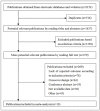Combination therapy versus pharmacotherapy, endoscopic variceal ligation, or the transjugular intrahepatic portosystemic shunt alone in the secondary prevention of esophageal variceal bleeding: a meta-analysis of randomized controlled trials
- PMID: 28915680
- PMCID: PMC5593651
- DOI: 10.18632/oncotarget.18143
Combination therapy versus pharmacotherapy, endoscopic variceal ligation, or the transjugular intrahepatic portosystemic shunt alone in the secondary prevention of esophageal variceal bleeding: a meta-analysis of randomized controlled trials
Abstract
Patients with liver cirrhosis and variceal hemorrhage are at increased risk of rebleeding. We performed a meta-analysis toassess the clinical efficacy of combination therapy (pharmacotherapy and endoscopic variceal ligation (EVL)) compared with pharmacotherapy, EVL, or transjugular intrahepatic portosystemic shunt (TIPS) alone in the prevention of rebleeding and mortality. A literature search of MEDLINE, EMBASE, and the Cochrane Controlled Trials Register, up until November 2016, identified relevant randomized controlled trials. Data analysis was performed using Stata 12.0. Regarding overall mortality, combination therapy was as effective as EVL, pharmacotherapy, and TIPS (relative risk (RR) = 0.62, 95% confidence interval (CI): 0.36-1.08, RR=1.05, 95% CI: 0.68-1.63, and RR=1.39, 95% CI: 0.92-2.09, respectively). Combination therapy was as effective as EVL and pharmacotherapy alone in reducing blood-related mortality (RR=0.43, 95% CI: 0.15-1.25, and RR=0.42, 95% CI: 0.17-1.06), whereas TIPS was more effective than combination therapy (RR=5.66, 95% CI: 1.02-31.40). This was also the case for rebleeding; combination therapy was more effective than EVL and pharmacotherapy alone (RR=0.57, 95% CI: 0.41-0.79, and RR=0.65, 95% CI: 0.48-0.88), whereas TIPS was more effective than combination therapy (RR=9.42, 95% CI: 2.99-29.65). Finally, regarding rebleeding from esophageal varices, combination therapy was as effective as EVL alone (RR=0.59, 95% CI: 0.33-1.06) and was more effective than pharmacotherapy alone (RR=0.58, 95% CI: 0.40-0.85), although was less effective than TIPS (RR=2.20, 95% CI: 1.22-3.99). TIPS was recommended as the first choice of therapy in the secondary prevention of esophageal variceal bleeding.
Keywords: endoscopic variceal ligation; esophageal varices; liver cirrhosis; transjugular intrahepatic portosystemic shunt.
Conflict of interest statement
CONFLICTS OF INTEREST All authors report there are no conflicts of interest related to the present article.
Figures
References
-
- D’Amico G. Esophageal Varices: From Appearance to Rupture; Natural History and Prognostic Indicators. In: Groszmann RJ, Bosch J, editors. Portal Hypertension in the 21st Century. Dordretch, the Netherlands: Kluwer Academic; 2004. pp. 147–154.
-
- D’Amico G, Pagliaro L, Bosch J. Pharmacological treatment of portal hypertension: an evidence-based approach. Semin Liver Dis. 1999;19:475–505. - PubMed
-
- Bosch J, Garcia-Pagan JC. Prevention of variceal rebleeding. Lancet. 2003;361:952–954. - PubMed
-
- Pagliaro L, Lebrec D, Poynard T, Hillon P, Benhamou JP. Propranolol for prevention of recurrent gastrointestinal bleeding in patients with cirrhosis. A controlled study. J Hepatol. 2002;36:148–150. - PubMed
-
- Villanueva C, Balanzo J, Novella MT, Soriano G, Sainz S, Torras X, Cusso X, Guarner C, Vilardell F. Nadolol plus isosorbide mononitrate compared with sclerotherapy for the prevention of variceal rebleeding. N Engl J Med. 1996;334:1624–1629. - PubMed
LinkOut - more resources
Full Text Sources
Other Literature Sources






